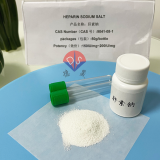Chinese VersionChina Suppliers > Hubei new DE sheng material science and technology co., LTD. > Precautions for using heparin sodium anticoagulant to collect blood vessels
- Search Product
-
-
- Region :China/Hubei
- Tel : +86-18971041571
- Fax :
- Email :vickyzhao@whdschem.com
- URL :
- Add :Guanggu United Science and Technology City C8, Ezhou City, Hubei Province
- Details for Precautions for using heparin sodium anticoagulant to collect blood vessels
-
Precautions for using heparin sodium anticoagulant to collect blood vessels
Category : Other Chemicals

CAS NO : 9041-8-1 EC NO : MF : MW : Specification : White Powder Packing : 500g/bottle Product description : Heparin sodium anticoagulation is mainly used to combat the activity and formation of thrombin, prevent platelet aggregation. As a fully enclosed blood collection vessel, heparin sodium anticoagulation tubes are not easily contaminated, have high plasma precipitation efficiency, and can directly shorten the artificial separation time to a certain extent, improve the detection speed, and also bring convenience to medical staff. Although heparin sodium can be widely used in vacuum test tubes, it is not blindly used, and some operators still do not know some precautions, resulting in poor anticoagulation effect or problematic results. So below, we will specifically introduce the precautions for using heparin sodium anticoagulants to collect blood vessels, in order to fundamentally prevent all problems from occurring. Precautions for using heparin sodium anticoagulant for blood collection: 1. In order to ensure that the blood collected in the test tube is fully exposed to heparin sodium, the operator needs to pay attention to slowly inverting the heparin sodium anticoagulant tube 6-8 times as soon as possible after the blood collection is completed, especially when the ambient temperature is too high, it needs to be mixed thoroughly, otherwise it may lead to blood coagulation or local coagulation. 2. Heparin anticoagulants are different from other types of anticoagulants. When using heparin sodium anticoagulants for blood collection, it is necessary to ensure that the test is completed within 6 hours after blood collection, otherwise the test results may be problematic because heparin is a non irreversible anticoagulant. 3. Pay attention to the amount of sodium heparin added, usually according to industry standards, and ensure that the blood sample is fully anticoagulated locally and completely, so as to ensure that most plasma indicators are normal. 4. Note that although heparin sodium can be added separately to anticoagulant tubes, it is not only allowed to be added in one form. It can also be used in combination with serum separation gel to ensure better separation and anticoagulant effects. 5. Most anticoagulant tubes are sterile and require irradiation sterilization. The addition of heparin sodium also has the same requirements, so be careful when using them γ Radiation irradiation, with a dose of approximately 8-25 kGy, can determine the initial colony count. 6. If sodium heparin is added to the anticoagulant tube and impurities or impurities appear, or if the color is not correct and the odor is pungent, it should be immediately stopped from use. It cannot be directly added to the tube, as it will affect the entire experimental detection process and results. The above are the precautions for using heparin sodium for anticoagulation and blood collection. As a beginner in contact with heparin sodium reagents, you should pay special attention and not use it blindly. As a professional manufacturer of blood collection reagents, Desheng has always stood in the customer's perspective, insisting on producing high-quality products. Therefore, if you have any needs for blood collection reagent raw materials, please click on the website or call for more information! Uses : Blood collection additive Synonyms : no data
- more>>Other Products
-
- • Biological buffer 3- [N, N-di (hydroxyethyl) amino] -2-hydroxypropanesulfonic acid DIPSO
- • Luminol Sodium Salt
- • 4-Aminophthalhydrazide
- • acridinium ester DMAE-NHS
- • acridinium ester NSP-DMAE-NHS
- • Acridine hydrochloride NSP-SA
- • Acridine hydrochloride NSP-SA-NHS
- • NSP-SA-ADH
- • acridinium ester ME-DMAE-NHS TOOS; 3-(N-Ethyl-3-Methylanilino)-2-Hydroxypropanesulfonic Acid Sodium Salt
- • TOPS; Sodium 3-(N-Ethyl-3-Methylanilino)Propanesulfonate; N-Ethyl-N-Sulfopropyl-M-Toluidine Sodium Salt
- • ADOS Sodium 3-(Ethyl(3-Methoxyphenyl)Amino)-2-Hydroxypropane-1-Sulfonate Dihydrate
- • ADPS N-Ethyl-N-(3-Sulfopropyl)-3-Methoxyaniline Sodium Salt
- • ALPS N-Ethyl-N-(3-Sulfopropyl)Aniline Sodium Salt; Sodium 3-(Ethyl(Phenyl)Amino)Propane-1-Sulfonate; Sodium
- • DAOS; Sodium 3-((3,5-Dimethoxyphenyl)(Ethyl)Amino)-2-Hydroxypropane-1-Sulfonate
- • HDAOS; N-(2-Hydroxy-3-Sulfopropyl)-3,5-Dimethoxyaniline Sodium Salt
- • MADB N,N-Bis(4-Sulfobutyl)-3,5-Dimethylaniline Disodium Salt
- • MAOS N-Ethyl-N-(2-Hydroxy-3-Sulfopropyl)-3,5-Dimethylaniline Sodium Salt Monohydrate
- • DAB 3,3',4,4'-Biphenyltetramine Tetrahydrochloride